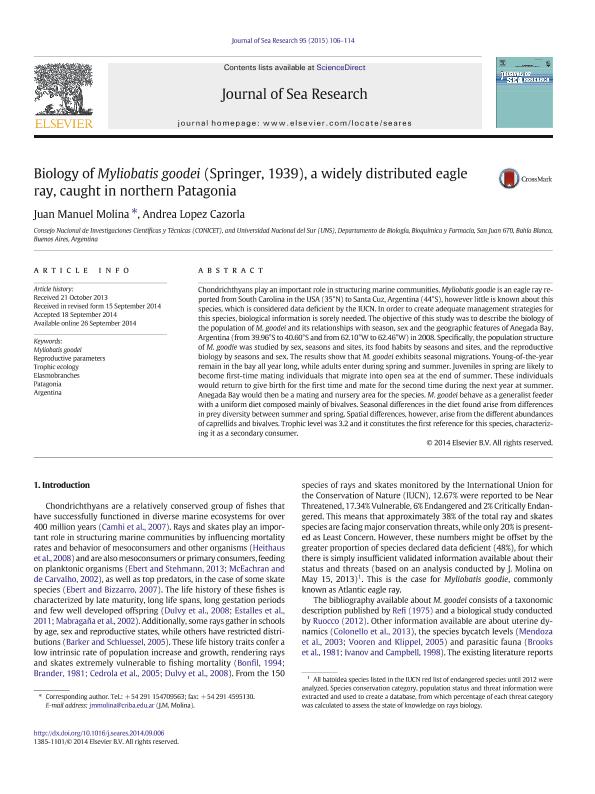Mostrar el registro sencillo del ítem
dc.contributor.author
Lopez Cazorla, Andrea Cecilia

dc.contributor.author
Molina, Juan Manuel

dc.date.available
2016-09-02T20:27:32Z
dc.date.issued
2015-01
dc.identifier.citation
Lopez Cazorla, Andrea Cecilia; Molina, Juan Manuel; Biology of Myliobatis goodei (Springer, 1939) a widely distributed eagle ray caught in northern Patagonia; Elsevier; Journal of Sea Research; 95; 1-2015; 106-114
dc.identifier.issn
1385-1101
dc.identifier.uri
http://hdl.handle.net/11336/7418
dc.description.abstract
Chondrichthyans play an important role in structuring marine communities. Myliobatis goodie is an eagle ray reported from South Carolina in USA (35°N) to Santa Cuz, Argentina (44°S), however little is known about this species, which is considered Data Deficient by the IUCN. In order to create adequate management strategies for this species, biological information is sorely needed. The objective of this study was to describe the biology of the population of M. goodei and its relationships with season, sex and the geographic features of Anegada Bay, Argentina (from 39.96°S to 40.60°S and from 62.10°W to 62.46°W) during 2008. Specifically, the population structure of M. goodie was studied by sex, seasons and sites, its food habits by seasons and sites, and the reproductive biology by seasons and sex. The results show that M. goodei exhibits seasonal migrations. Young-of-the-year remain in the bay all year long, while adults enter during spring and summer. Juveniles in spring are likely to become first-time mating individuals that migrate into open sea at the end of summer. These individuals would return to give birth for the first time and mate for the second time during the next year at summer. Anegada Bay would then be a mating and nursery area for the species. M. goodei behave as a generalist feeder with a uniform diet composed mainly of bivalves. Seasonal differences in the diet found arise from differences in prey diversity between summer and spring. Spatial differences, however, arise from the different abundances of caprelids and bivalves. Trophic level was 3.2 and it constitutes the first reference for this species, characterizing it as a secondary consumer.
dc.format
application/pdf
dc.language.iso
eng
dc.publisher
Elsevier

dc.rights
info:eu-repo/semantics/openAccess
dc.rights.uri
https://creativecommons.org/licenses/by-nc-nd/2.5/ar/
dc.subject
Myliobatis Goodei
dc.subject
Reproductive Parameters
dc.subject
Trophic Ecology
dc.subject
Elasmobranches
dc.subject
Patagonia
dc.subject
Argentina
dc.subject.classification
Biología Reproductiva

dc.subject.classification
Ciencias Biológicas

dc.subject.classification
CIENCIAS NATURALES Y EXACTAS

dc.subject.classification
Conservación de la Biodiversidad

dc.subject.classification
Ciencias Biológicas

dc.subject.classification
CIENCIAS NATURALES Y EXACTAS

dc.subject.classification
Ecología

dc.subject.classification
Ciencias Biológicas

dc.subject.classification
CIENCIAS NATURALES Y EXACTAS

dc.title
Biology of Myliobatis goodei (Springer, 1939) a widely distributed eagle ray caught in northern Patagonia
dc.type
info:eu-repo/semantics/article
dc.type
info:ar-repo/semantics/artículo
dc.type
info:eu-repo/semantics/publishedVersion
dc.date.updated
2016-07-12T15:22:16Z
dc.journal.number
95
dc.journal.pagination
106-114
dc.journal.pais
Países Bajos

dc.journal.ciudad
Amsterdam
dc.description.fil
Fil: Lopez Cazorla, Andrea Cecilia. Consejo Nacional de Investigaciones Cient__itilde__ficas y T__etilde__cnicas; Argentina. Universidad Nacional del Sur; Argentina
dc.description.fil
Fil: Molina, Juan Manuel. Consejo Nacional de Investigaciones Cient__itilde__ficas y T__etilde__cnicas; Argentina. Universidad Nacional del Sur; Argentina
dc.journal.title
Journal of Sea Research

dc.relation.alternativeid
info:eu-repo/semantics/altIdentifier/url/http://www.sciencedirect.com/science/article/pii/S138511011400166X
dc.relation.alternativeid
info:eu-repo/semantics/altIdentifier/doi/http://dx.doi.org/10.1016/j.seares.2014.09.006
Archivos asociados
